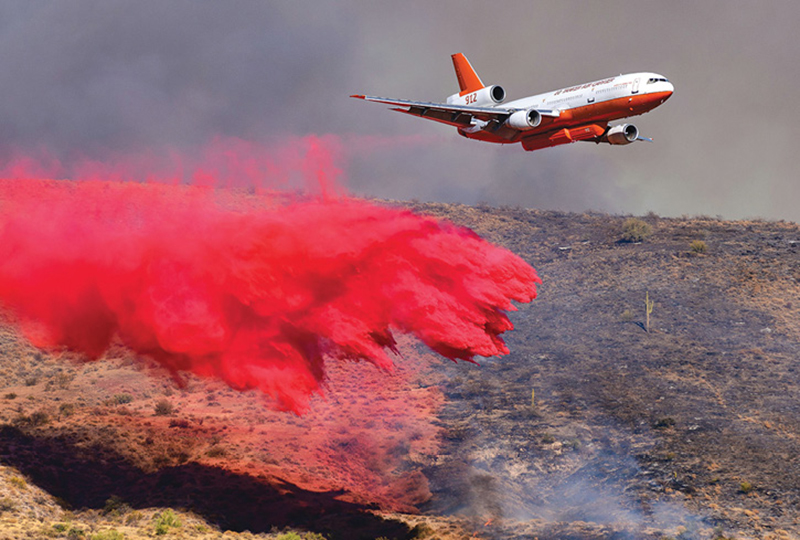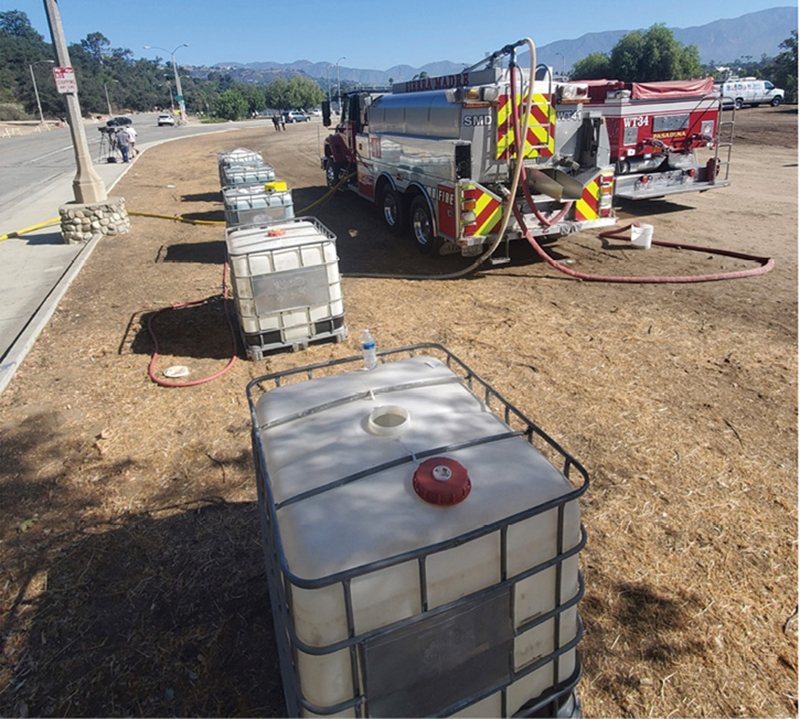Foam makers offer an array of foams and fire retardants for use in wildland firefighting, including products that function to slow, stop, or extinguish an advancing fire as well as those that are used in the protection of homes, outbuildings, and other human-made structures.
Rich Snyder, a consultant for Allied Disaster Defense and a retired captain with 36 years at the Sierra Madre (CA) Fire Department, says his department has been using PHOS-CHEK® fire retardants on wildland fires for more than 30 years as well as treating vegetation in the wildland urban interface (WUI) as a preventive measure. “Sierra Madre Fire has a water tender we bought from the U.S. Forest Service (USFS) where we mix PHOS-CHEK so the retardant solution can be sprayed in canyons and on hillsides to protect homes in case of a wildland fire,” Snyder points out.
Snyder says that when the 2020 Bobcat Fire, which started in the Angeles National Forest, made a run toward the cities of Sierra Madre, Arcadia, and Monrovia, the three cities ordered three totes of 265 gallons each of PHOS-CHEK LC95 long-term fire retardant to protect city infrastructure, evacuation routes, and other key facilities in all three cities. “One of the facilities was the historic Trask Boy Scout Camp located in the foothills above Monrovia,” Snyder notes. “Due to COVID, the camp had been vacant and the vegetation around the cabins and infrastructure had not been maintained to the level it had in the past. Sierra Madre Fire mixed approximately 1,800 gallons of PHOS-CHEK LC 95 and applied it around the camp’s buildings and infrastructure. Several days later, the fire made it into the canyon, but none of those structures were lost because the fire could not make it past the PHOS-CHEK lines placed around each building.”
Cheryl Muranko, Canadian air tanker service manager for Perimeter Solutions, the maker of PHOS-CHEK, says wildland fire managers use Class A foams as fire suppressants and retardants because they work so well on vegetation, wood, paper, and rubber products. “The foam concentrate contains surfactants that reduce the surface tension of the water and spread the water molecules to allow them to cool and take the heat out of the fire triangle,” Muranko observes. “Also, foam’s expansion properties allow the formulation of an insulating blanket over the fuel, which breaks down the oxygen side of the triangle.”

1 An air tanker makes a drop of PHOS-CHEK WD881 on a wildland fire. (Photo courtesy of Perimeter Solutions.)

2 The Sierra Madre (CA) Fire Department uses a tanker to mix LC 95 for application on the Bobcat Fire that started in the Angeles National Forest. [Photos 2 and 3 courtesy of the Sierra Madre (CA) Fire Department.]

3 A Sierra Madre firefighter applies Thermo-Gel fire gel on a structure threatened by wildfire.
Muranko notes that PHOS-CHEK WD881 and WD881C Class A foam, as well as PHOS-CHEK First Response foam, are used on wildland fires in both Canada and the United States. “The injection rates of these foams can be changed according to the tactics used by the wildland firefighting team,” she says. “For instance, a wet foam penetrates much deeper into the fuel, while a drier foam breaks down the fire’s ability for an oxygen exchange. Typical injection rates range from 0.1% to 1% foam concentrate and, when applied from the air, aerial assets usually put down wet foam with the first drop, then drier foam for the second drop.”
Both suppressant foams and long-term retardant foams can be applied either from the air or on the ground, Muranko points out. When used via aerial application, foam is generally applied as a direct attack, either at the head of the fire or along its sides. “On the ground, foams can be very useful when mopping up hot spots after a fire has moved through,” she says. “It’s also used to set up a wet line when starting a back burn, to reinforce fire control lines, to protect ingress and egress for firefighters, and to protect structures and utility poles.”
Snyder notes that Sierra Madre Fire has used fire gels around structures in the WUI as a protective measure. “We have used Barricade around structures and to apply to the sides of houses,” he says. “It’s a thick gel of water bubbles instead of air bubbles and is good protection. We also have used Thermo-Gel, which sticks well to structure walls and consists of small water bubbles instead of foam bubbles.”
J.C. Barb, vice president of operations for Enforcer One, says his company makes FIREBULL™ Class A foam that’s used in wildland firefighting. “It’s a fluorine-free wetting agent that has application rates from 0.1% to 1% and contains no PFAS,” Barb points out. He adds that Enforcer One also makes FIREBULL AB foam that’s dual-rated as a Class A and Class B foam by Underwriters Laboratories and that the dual foam is useful in dealing with the trees, wood, grass, and vegetation found in wildland situations.
Dan Reese, retired chief of tactical operations for CAL FIRE, says one of his responsibilities was management of the wildland fire chemical program. The foams Reese worked with most were PHOS-CHEK’s WD881 and First Response foams and also WetWater and Silvex foams. “There are different ways foam is employed in wildland fire situations,” Reese observes. “You might use a wet foam that has a blanket-like effect for structure protection, but for mop-up operations you’ll want to use a low-expansion foam where there isn’t a huge amount of bubbles but a change in surface tension to get better penetration.”
ALAN M. PETRILLO is a Tucson, Arizona-based journalist, the author of three novels and five nonfiction books, and a member of the Fire Apparatus & Emergency Equipment Editorial Advisory Board. He served 22 years with the Verdoy (NY) Fire Department, including in the position of chief.

